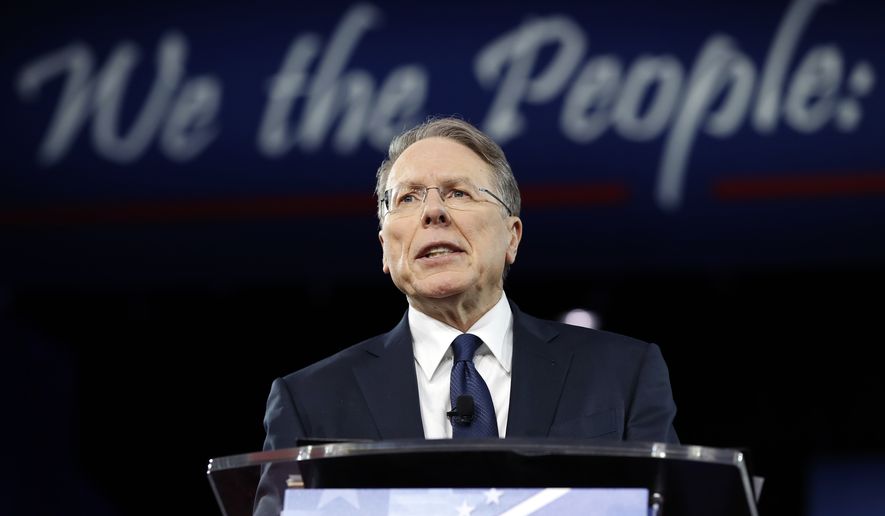The National Rifle Association has become politically toxic in Washington, with even President Trump chiding lawmakers this week as afraid to buck the powerful Second Amendment rights organization.
But the true extent of the NRA’s power remains a source of contention as Congress begins another gun control debate. Gun control groups, their Democratic allies in Washington and now even Mr. Trump say they must battle the group’s approach.
The NRA’s fabled influence has drawn criticism from both sides. Senate Minority Leader Charles E. Schumer, New York Democrat, said the organization has Republicans in a “grip lock.”
Rep. Scott Taylor, Virginia Republican, said the NRA became the “boogeyman” after the killing last month of 17 people at a Parkland, Florida, high school.
“We have to elect candidates that are not funded by the NRA,” Hollywood analyst Chelsea Handler tweeted. “It is disgusting how many times this has happened, and Republicans do nothing. You all have blood on your hands.”
But the electoral scorecard shows that the NRA represents many people and is effective.
Measured by money and candidates, the NRA ranks among the most successful lobbying groups. Its candidates prevailed in 73.3 percent of the 2016 races where the NRA picked sides, and when judged by spending, 94.4 percent of the organization’s political money supported successful candidates.
But claims about the NRA’s spending often outstrip the reality.
“It’s kind of hard to nail down an exact number for any of these groups,” said Brendan Quinn, a spokesman at the Center for Responsive Politics that runs OpenSecrets.
In November, OpenSecrets issued a press release proclaiming that NRA spending had “surged $100 million amidst pro-Trump push in 2016.” Yet it turns out the $100 million figure reflects the jump in the NRA’s entire budget, meaning salaries, rent, cars, insurance, equipment, political campaigns — everything.
An OpenSecrets bulletin last month showed 2016 Democratic presidential nominee Hillary Clinton collected more money from gun control groups than Mr. Trump received from gun rights groups.
The NRA concedes that it spent more than ever before on presidential and congressional races in 2016, but the final tally wasn’t anything close to $100 million, according to federal documents.
Probably the best available figure for the NRA’s spending in 2016 is $58.5 million, Mr. Quinn said. That total represents the sum of the NRA’s direct contributions ($1.1 million), lobbying ($3.1 million), and “outside expenditures” ($54.4 million).
That year, the biggest spending group was the liberal political action committee known as Priorities USA, with reported spending of $133.4 million.
The NRA’s political spending has always leaned conservative, but that slant has become much more pronounced since President Obama was in office. In 2010, for instance, the gun rights group had its biggest year in terms of direct contributions, doling out $1.4 million, records show. That money was split 73 percent to 27 percent in favor of Republicans. In 2016, on the other hand, 99 percent of the NRA’s $1.1 million contributions went to Republicans.
Nor is the NRA one of the 10 biggest political donors historically. By far the biggest contributor on that table is the Service Employees International Union with $280.2 million. Indeed, six of the 10 players on that list are unions, whose reported combined spending topped $838 million, according to OpenSecrets.
The NRA declined to comment when asked about the perception of its spending, though it has said its effective voice in the public sphere rests on much more than mere dollar. The group declined to provide figures to support what it says has been an uptick in membership and contributions in the past two weeks.
“When people feel their constitutional rights are being jeopardized, they become active,” NRA spokeswoman Jennifer Baker said.
The NRA’s contention that because its members are especially politically motivated, its support matters more at the ballot box than a check does, has some empirical basis. In July, the last time the Pew Research Center took a deep dive on Americans’ thinking about guns, it found that while only 30 percent reported owning guns, 75 percent of those who did saw it as “essential to their personal sense of freedom.”
“What you see is there are many more people interested in protecting the Second Amendment than there are interested in destroying it,” said Shawn Steele, one of California’s representatives on the Republican National Committee.
The NRA’s overall political spending does top gun control groups such as Everytown for Gun Safety or Giffords, two of the most prominent organizations.
Yet the numbers were flipped at the presidential level. OpenSecrets showed Mr. Trump received $969,138 from gun rights groups, less than the $1.1 million Mrs. Clinton received from gun control groups in the 2016 election.
Neither Everytown nor Giffords responded to requests for comment.
The NRA easily outstripped those groups in spending on lobbying — particularly last year when the NRA lobbying bill soared north of $5 million. But the gun control advocates are far from inactive. From 2014 to 2017, Everytown spent nearly $6 million on lobbying.
The NRA did not respond to written questions about why its lobbying total was much higher last year than it had been in any other year since at least 2007.
Giffords PAC boasted of its work on behalf of Sen. Margaret Wood Hassan, the New Hampshire Democrat who ousted incumbent Republican Kelly Ayotte in 2016. It also was active in five races last year.
Giffords has also partnered with several prominent white shoe law firms, including Covington & Burling, Arnold & Porter, Denton and others to pursue “legal strategies” and to go after gun manufacturers.
Giffords announced Feb. 20, a week after the Florida high school killings, that it would launch a six-figure ad buy against Gov. Rick Scott, a Republican who is expected to seek the state’s U.S. Senate seat in November.
• James Varney can be reached at jvarney@washingtontimes.com.




Please read our comment policy before commenting.